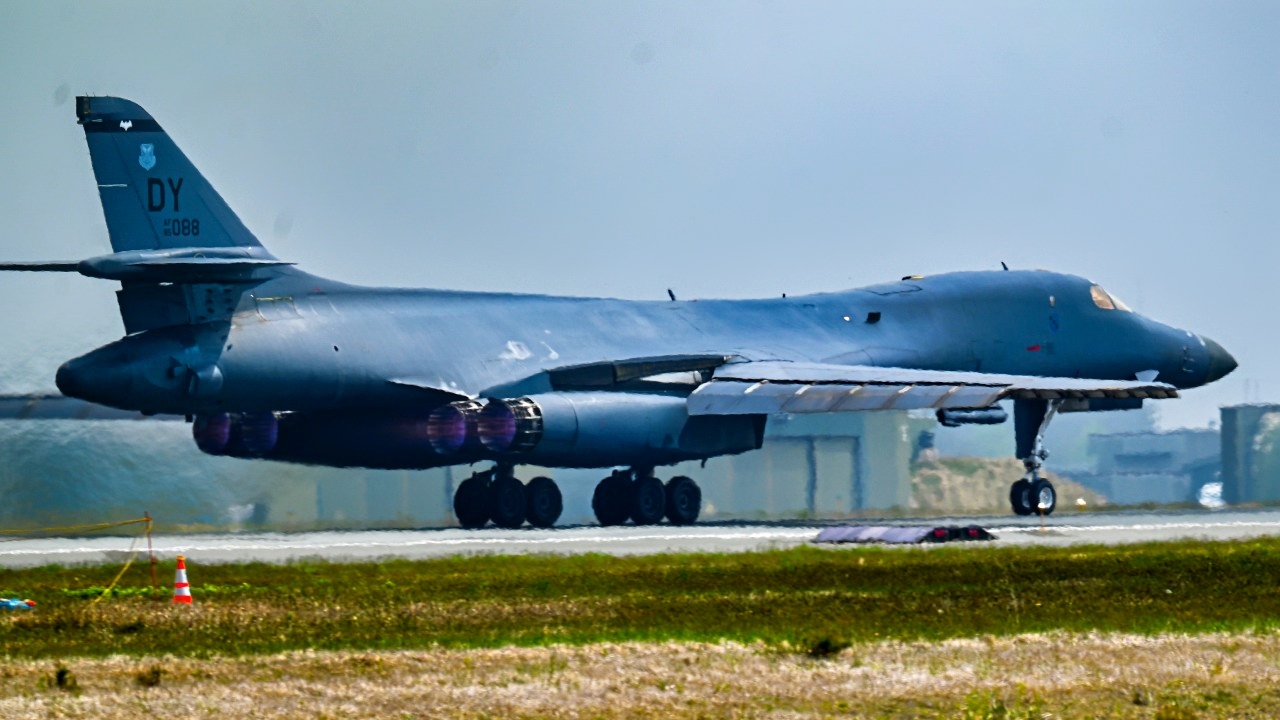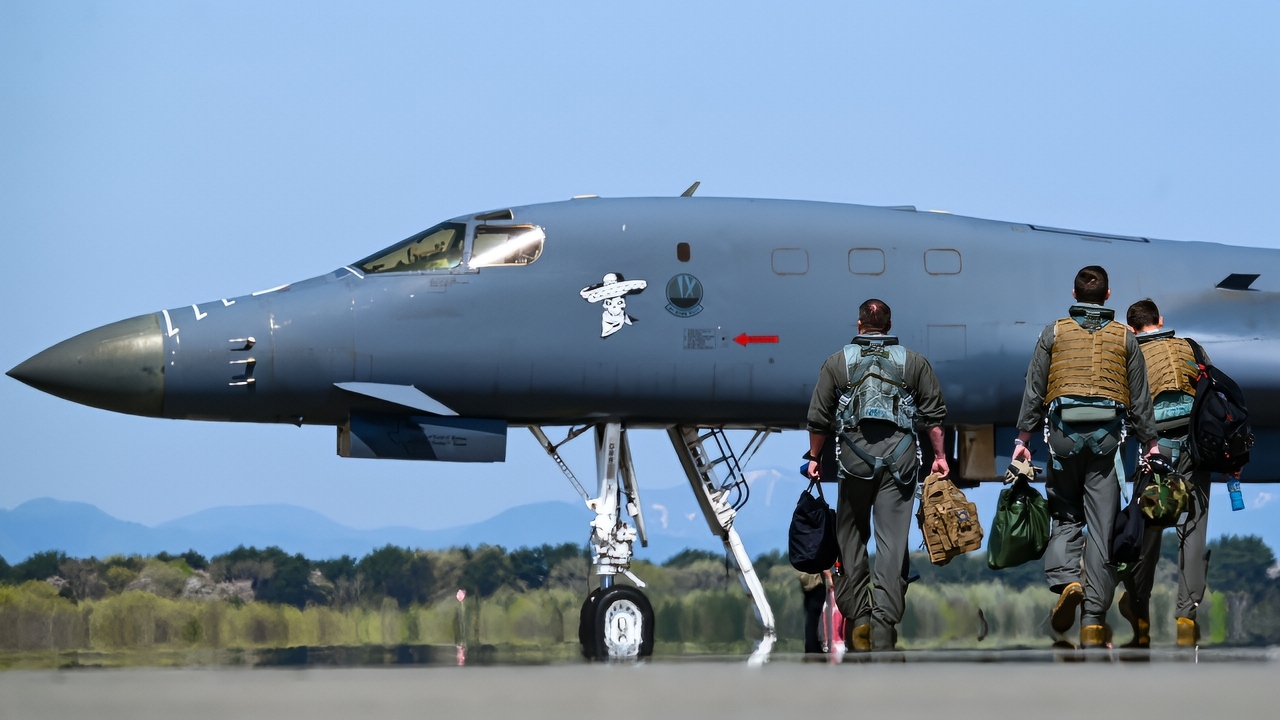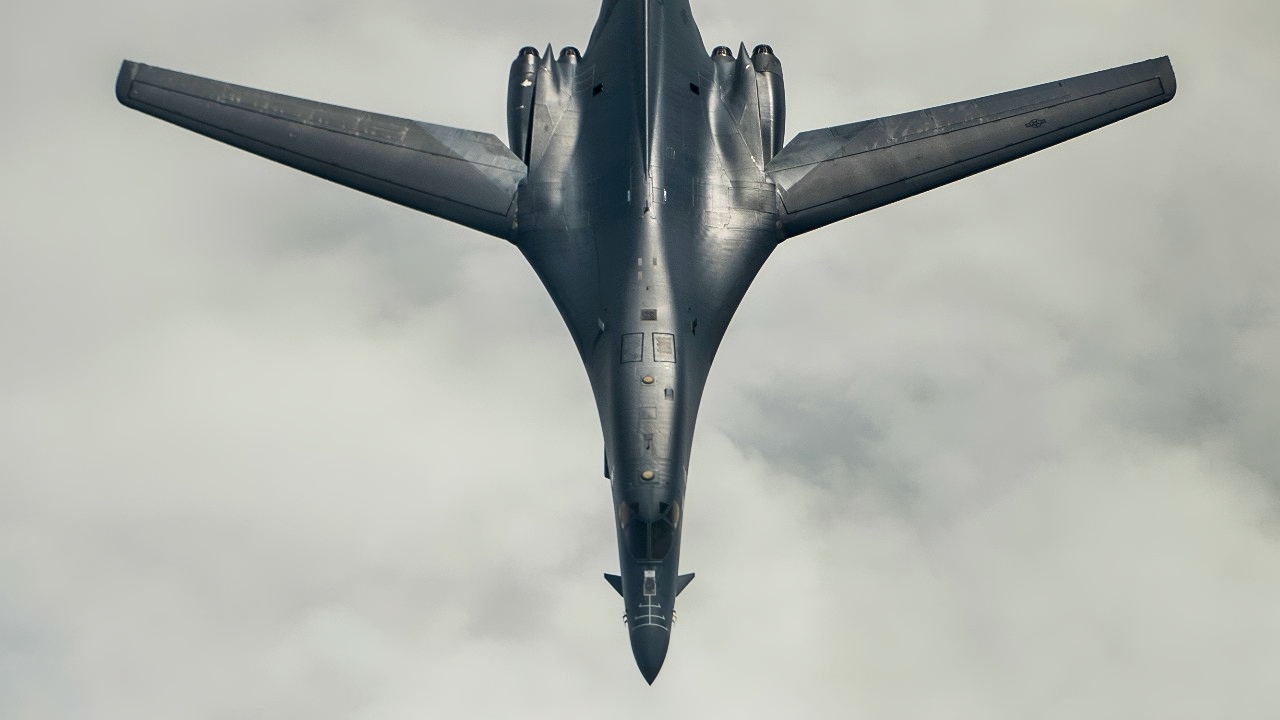Key Points and Summary – The B-1 bomber program was famously canceled in 1977 by President Jimmy Carter, who deemed the supersonic nuclear bomber too expensive and unnecessary in the age of cruise missiles. However, the program was resurrected by President Ronald Reagan in 1981 as the redesigned B-1B Lancer.
-This new version was slower but carried a larger payload and had a greatly reduced radar cross-section.

A U.S. Air Force B-1B Lancer assigned to the 34th Expeditionary Bomb Squadron, Ellsworth Air Force Base, South Dakota, flies over the United States, July 2, 2025. The B-1B is a heavy bomber with up to a 75,000 pound payload. (U.S. Air National Guard photo by Airman Spencer Strubbe)
-While it never performed its original nuclear mission, the B-1B was later converted into a spectacularly effective conventional bomber, vindicating its revival in conflicts over Iraq, Kosovo, and Afghanistan.
B-1B Lancer: Why the Carter Administration Tried to End It
Though not as venerable or battle-hardened as the septuagenarian Boeing B-52 Stratofortress, the Rockwell B-1B Lancer (also known as the “Bone”) turned out to be a long-lasting and highly effective strategic bomber for the U.S. Air Force. Indeed, the base B-1 design is more than 50 years old.
But back in the day, it looked like the Bone wouldn’t even live long enough to see its fifth birthday, let alone its 50th, thanks to the Jimmy Carter administration.
So why did then-President Carter try to kill the B-1?
FFKC (Forged by Ford, Killed by Carter)
The Bone started off life as the B-1A, which was envisioned as a supersonic, lower-altitude replacement for the B-52. It was initially designed strictly for doomsday missions—nuclear strike—and not for a conventional bombing role.
It made its maiden flight on Dec. 23, 1974, with Gerald R. Ford in the Oval Office. When Ford departed the White House in January 1977, he left behind a long-range budget that funded 244 B-1s. However, Ford’s successor, Carter, had other, more pacifistic ideas.

A B-1B Lancer prepares to return to Dyess Air Force Base, Texas, during Bomber Task Force 25-2 at Misawa Air Base, Japan, May 15, 2025. BTF missions provide opportunities to train and work with our allies and partners in joint and combined operations and exercises. (U.S. Air Force photo by Airman 1st Class Mattison Cole)
As noted in 2006 by renowned Air Force historian Walter J. Boyne:
“The more-dovish Carter took office holding strong views about national defense generally and manned penetrating bombers in particular. The new President believed the Soviet Union would react favorably if Washington unilaterally constrained its strategic nuclear programs.
“The Democrat believed he should slow down or stop programs that could derail superpower arms control.
“Most observers expected Carter to cancel the B-1, and, on June 30, 1977, he did just that. In explanation, he called it ‘a very expensive weapon’ that was ‘not now necessary’ because of the ‘recent evolution of the cruise missile.’ Despite the efforts of Air Force and some Congressional leaders, Carter could not be made to see the value of a penetrating bomber.”
In other words, the peanut farmer turned POTUS took a pacifistic approach toward the Soviet adversary.
He seemed to blissfully disregard the fact that the Soviet Union possessed an arsenal bristling with about 200 land divisions, some 1,500 intercontinental ballistic missiles, 900 submarine-launched missiles, 700 long-range bombers, 8,400 tactical aircraft, and a formidable integrated air defense system.
RRR (Resurrected by Ronald Reagan)
Luckily for the Air Force bomber community, when Ronald Reagan unseated Jimmy Carter, he utterly eschewed Carter’s accommodationist approach toward the Soviet Union, instead denouncing it as an “Evil Empire” and backing up those words with a revitalized defense buildup.
Thus the Lancer was given a new lease on life as the B-1B. The redesign went into effect in 1981 and made its maiden flight in prototype form in 1983. The first production-phase B-1B was unveiled in 1984, and it finally entered official operational service on Oct. 1, 1986. A total of 102 airframes were built, with the last specimen delivered on May 2, 1988.

9th Expeditionary Bomb Squadron aircrew step out to the B-1B Lancer during Bomber Task Force 25-2 at Misawa Air Base, Japan, May 9, 2025. BTF 25-2 demonstrates Allied strength by forging strong alliances, showcasing our resolve, and deterring aggression, while also supporting global stability and security and strengthening military capabilities. (U.S. Air Force photo by Airman 1st Class Mattison Cole)
This resurrected version of the Bone was heavier and slower than the B-1A. It had a maximum takeoff weight of 477,000 pounds and flew at speeds as high as Mach 1.2 (as opposed to the Mach 2.2 of the B-1A).
But the B-1B packed a heavier weapons payload—an increase of 74,000 lbs.—and had a significantly improved radar. It also benefited from a redesigned inlet, and overall, the warbird’s radar cross-section was reduced to roughly 10 percent of the B-1A, thus boosting survivability.
Just more than five years after the B-1B attained operational status, the Cold War ended, and thus the Bone never got to fulfill its originally intended nuclear mission. The Bone also missed out on the 1991 Persian Gulf War. It hadn’t yet been converted to carry conventional munitions, so it was the B-52 crews that got to have all the fun carpet-bombing Iraqi strongman Saddam Hussein’s elite Republican Guard troops.
Alive and Well: The Bone is Vindicated
In 1994, as part of the post-Cold War’s so-called “peace dividend,” the B-1B’s nuclear capabilities were deactivated, and the switch to conventional munitions capacity commenced.
Thus it came to pass that the Bone was given yet another new lease on life—and it prospered in its new role, demonstrating its versatility and vindicating Reagan’s decision to revive it.
The Bone was blooded in combat during Operation Desert Fox from Dec. 16-19, 1998; this was the bombing campaign spurred by Saddam Hussein’s continued refusal to cooperate with United Nations weapons inspectors. The aircraft’s primary mission was to strike military targets in Iraq that contributed to the country’s ability to produce, store, maintain, and deliver weapons of mass destruction.

A U.S. Air Force B-1B Lancer, assigned to the 37th Expeditionary Bomb Squadron, Ellsworth Air Force Base, S.D., flies over the East China Sea, Jan. 9, 2018. The Lancer serves as premier platform for America’s long-range bomber force, carrying the largest conventional payload of guided and unguided weapons in the Air Force inventory. (U.S. Air Force photo by Staff Sgt. Peter Reft)
From there, the B-1B’s combat record really took off, as noted by the official U.S. Air Force Fact Sheet:
“In 1999, six B-1s were used in Operation Allied Force, delivering more than 20 percent of the total ordnance while flying less than 2 percent of the combat sorties.
“During the first six months of Operation Enduring Freedom, eight B-1s dropped nearly 40 percent of the total tonnage delivered by coalition air forces. This included nearly 3,900 JDAMs, or 67 percent of the total. In Operation Iraqi Freedom, the aircraft flew less than 1 percent of the combat missions while delivering 43 percent of the JDAMs used.”
About the Author: Christian D. Orr, Defense Expert
Christian D. Orr is a Senior Defense Editor. He is a former Air Force Security Forces officer, Federal law enforcement officer, and private military contractor (with assignments worked in Iraq, the United Arab Emirates, Kosovo, Japan, Germany, and the Pentagon). Chris holds a B.A. in International Relations from the University of Southern California (USC) and an M.A. in Intelligence Studies (concentration in Terrorism Studies) from American Military University (AMU). He is also the author of the newly published book “Five Decades of a Fabulous Firearm: Celebrating the 50th Anniversary of the Beretta 92 Pistol Series.”
More Military
Army MV-75 Has a “Digital Backbone” to Stand Up to China in the Pacific
The F-35 Stealth Fighter Great Leap Forward Has Arrived
New Challenger 3 NATO Tank Is Built for Just 1 Mission It Can’t Fulfill
Sunk 10,000 Feet Down: A U.S. Navy Nuclear Submarine Was Lost, And No One Knows Why










